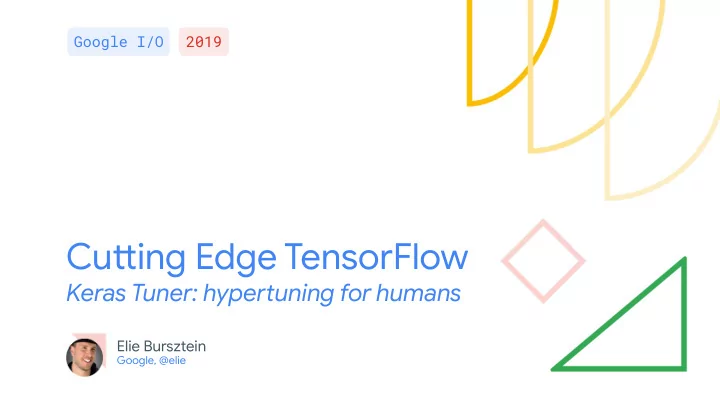

Google I/O 2019 Cutuing Edge TensorFlow Keras Tuner: hyperuuning for humans Elie Bursztein Google, @elie
? ? ?
Getuing the optimal model requires to tune many inter-dependent parameters
What if… hyperuuning was as easy as 1, 2, 3?
Introducing Keras Tuner Hyperuuning for humans
Keras Tuner is a framework designed for: AI practitioners Hyperuuner algorithm Model designers creators
With Keras Tuner hyperuuning is just a few lines of code away
A basic MNIST model model = Sequential() model.add(Conv2D(32, kernel_size=(3, 3), activation='relu', input_shape=(28, 28, 1))) model.add(Conv2D(64, kernel_size=(3, 3), activation='relu')) model.add(Flatten()) model.add(Dense(20, activation='relu')) model.add(Dropout(0.2)) model.add(Dense(10, activation='softmax')) model.compile(loss='categorical_crossentropy', optimizer=Adam(0.001)) model.summary()
MNIST hypermodel is as easy as 1,2,3 1. Wrap model in def model_fn(): a function
MNIST hypermodel is as easy as 1,2,3 1. Wrap model in def model_fn(): a function LR = Choice('learning_rate', [0.001, 0.0005, 0.0001], group='optimizer') DROPOUT_RATE = Linear('dropout_rate', 0.0, 0.5, 5, group='dense') NUM_DIMS = Range('num_dims', 8, 32, 8, group='dense') 2. Define NUM_LAYERS = Range('num_layers', 1, 3, group='dense') hyper-parameters L2_NUM_FILTERS = Range('l2_num_filters', 8, 64, 8, group='cnn') L1_NUM_FILTERS = Range('l1_num_filters', 8, 64, 8, group='cnn')
MNIST hypermodel is as easy as 1,2,3 1. Wrap model in def model_fn(): a function LR = Choice('learning_rate', [0.001, 0.0005, 0.0001], group='optimizer') DROPOUT_RATE = Linear('dropout_rate', 0.0, 0.5, 5, group='dense') NUM_DIMS = Range('num_dims', 8, 32, 8, group='dense') 2. Define NUM_LAYERS = Range('num_layers', 1, 3, group='dense') hyper-parameters L2_NUM_FILTERS = Range('l2_num_filters', 8, 64, 8, group='cnn') L1_NUM_FILTERS = Range('l1_num_filters', 8, 64, 8, group='cnn') model = Sequential() model.add(Conv2D(L1_NUM_FILTERS, kernel_size=(3, 3), activation='relu')) model.add(Conv2D(L2_NUM_FILTERS, kernel_size=(3, 3), activation='relu')) model.add(Flatten()) 3. Replace static for _ in range(NUM_LAYERS): value with model.add(Dense(NUM_DIMS, activation='relu')) hyper-parameters model.add(Dropout(DROPOUT_RATE)) model.add(Dense(10, activation='softmax')) model.compile(loss='categorical_crossentropy', optimizer=Adam(LR)) return model
MNIST hypermodel is as easy as 1,2,3 1. Wrap model in def model_fn(): a function LR = Choice('learning_rate', [0.001, 0.0005, 0.0001], group='optimizer') ___ DROPOUT_RATE = Linear('dropout_rate', 0.0, 0.5, 5, group='dense') NUM_DIMS = Range('num_dims', 8, 32, 8, group='dense') 2. Define ___ NUM_LAYERS = Range('num_layers', 1, 3, group='dense') ___ hyper-parameters L2_NUM_FILTERS = Range('l2_num_filters', 8, 64, 8, group='cnn') L1_NUM_FILTERS = Range('l1_num_filters', 8, 64, 8, group='cnn') model = Sequential() model.add(Conv2D(L1_NUM_FILTERS, kernel_size=(3, 3), activation='relu')) model.add(Conv2D(L2_NUM_FILTERS, kernel_size=(3, 3), activation='relu')) model.add(Flatten()) 3. Replace static for _ in range(NUM_LAYERS): value with model.add(Dense(NUM_DIMS, activation='relu')) hyper-parameters model.add(Dropout(DROPOUT_RATE)) model.add(Dense(10, activation='softmax')) model.compile(loss='categorical_crossentropy', optimizer=Adam(LR)) return model
Intuitive State of the aru API hyperuuner algorithms Tunable architectures Seamless experiments ready to go recording State of the aru Hypermodel Seamless Intuitive hyperuuner designed to be experiment API algorithms hyperuuned recording
Malware Spam Phishing
Let’s build a simple logo classifjer!
Loading the dataset 151 logo & icons from icongenerator.dataset import io19 ICON_SIZE = 100 NUM_EPOCHS = 5 BATCH_SIZE = 128 NUM_GEN_ICONS_PER_EPOCH = 50000 dataset = io19.download()
from icongenerator import TFGenerator AUGMENTATION_PARAMS = { "background_frequency": 0.5, "shape_frequency": 0.5, Adding data "min_logo_size": 0.50, "max_logo_size": 0.95, augmentation "use_flips": True, "occlusion": "light", "use_logo_color_shift": True, "blur": 1.0, "max_rotation": 45, "max_affine_transformations": 2, "use_background_color_shift": True, "use_shape_color_shift": True, "min_logo_alpha": 230 } tfg = TFGenerator(dataset, icon_size=ICON_SIZE, **AUGMENTATION_CONFIG)
Training ResNet101v2 as baseline base_model = ResNet101v2(input_shape=(100, 100, 3), weights=None, include_top=False) x = GlobalAveragePooling2D()(base_model.output) y = Dense(100 * 100 * 3, activation='sigmoid')(x) decoded = Reshape((100, 100, 3), name='reconstruction')(y) x = Flatten()(x) prediction = Dense(kg.num_classes, activation='softmax', name='label')(x) model = Model(base_model.input, [prediction, decoded]) model.compile(optimizer='adam', loss=['categorical_crossentropy', 'mse'] metrics=['accuracy']) model.fit_generator(kg, epochs=NUM_EPOCHS, validation_data=kg.val_data, callbacks=callbacks)
Training worked but model accuracy is low: 79.6% and it’s big: 44M parameters Let’s use Keras Tuner to fjnd a more accurate model and smaller model!
Keras Tuner TunableResNet def model_fn(): Use tunable base_model = TunableResNet(input_shape=(100, 100, 3)) ResNet as base x = base_model.output x = GlobalAveragePooling2D()(x) y = Dense(100 * 100 *3, activation='sigmoid')(x) decoded = Reshape((100, 100, 3), name='reconstruction')(y) Customize it to prediction = Dense(generator.num_classes, activation='softmax')(x) support our model = Model(base_model.input, [prediction, decoded]) multi-head output model.compile(optimizer=optimizers.Adam(LEARNING_RATE), loss=['categorical_crossentropy', 'mse'] metrics=['accuracy']) return model Init hypertuner tuner = Tuner(model_fn, 'val_accuracy' epoch_budget=500, max_epochs=5) tuner.search(tfg,validation_data=validation_data) Tuning
Yay! Keras Tuner found a betuer model with 100% accuracy (+20%) and only 24M parameters (-45%) Dataset is small so there is a possibility of overgit despite using augmented icons in training
Ecosystem integration ... TensorBoard Colab BigQuery Command line More to come!
One more thing! Because everyone like surprises
Online dashboard Monitoring on the go!
Alpha version -- Non fjnal UI
Sign up today for Keras Tuner alpha to help us making it awesome! htups://g.co/research/kerastunereap Sign up today! g.co/research/kerastuner
Recommend
More recommend